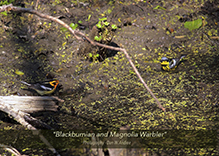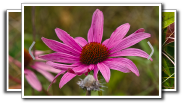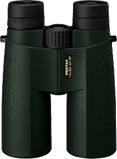Blackburnian Warbler
(Setophaga fusca)
Conservation • Description • Habitat • Ecology • Distribution • Taxonomy
Conservation Status |
|||
| IUCN Red List | LC - Least Concern |
||
| NatureServe | N5 - Secure SNRB - Unranked Breeding |
||
| Minnesota | not listed |
||
Description
The upper breast and throat are bright orange on the male, yellowish-orange on the female. The sides of the neck, arc below the eye, line above the eye, and stripe on the forecrown are yellowish-orange on the male, orangish-yellow on the female. The line above the eye and that on the side of the neck form a solid angular patch. The head, facepatch, and back are black on the male, brown on the female. The wings are black with a large white patch on the male, brown with two white wingbars on the female. The belly and undertail coverts are white or yellowish. The flanks and sides are streaked.
Size
Total length: 5″ to 5½″
Wingspan: 8″ to 8¾″
Voice
The song is brief and in two parts: a slow opening series of high, clear couplets followed by a ultra-high-pitched trilling, and ending in an extremely high-pitched tone, tsi tsi tsi tsi tsi ti ti ti ti ti seeeeee. The last note is the highest of any commonly heard North American Warbler, and it is often inaudible to older listeners.
Similar Species
Habitat
Breeding: Mature coniferous and mixed forests with tall trees
Migration: Forests, woodlands, scrubs, and thickets; especially areas with dense, tall, second growth, like state and county parks.
Ecology
Migration
Early May to early June and mid-August to late September.
Nesting
The nest is built high in a tall conifer
Food
Distribution
Occurrence
Fairly common but local in Northeastern Minnesota
According to the International Union for Conservation of Nature and Natural Resources (IUCN), Blackburnian Warbler has an “ extremely large range.” The population size is “extremely large” and appears to be increasing. In Minnesota, it is fairly common in the northeastern and north central counties. During migration, it is found throughout the state.
Maps
The Minnesota Ornithologists’ Union All Seasons Species Occurrence Map
Taxonomy
Class
Aves (birds)
Order
Passeriformes (perching birds)
Family
Parulidae (New World warblers)
Genus
Setophaga
Genus
In 2011 all of the wood warblers were reclassified resulting in new genus names for almost all of them. The genus Dendroica, with 29 members, was merged with the genus Setophaga, with just 3 members. All of the former Dendroica species have been renamed to Setophaga. Blackburnian Warbler, formerly Dendroica fusca, is now Setophaga fusca.
Subordinate Taxa
Synonyms
Dendroica fusca
Motacilla fusca
Visitor Photos
Share your photo of this bird.
This button not working for you?
Simply email us at info@MinnesotaSeasons.com.
Attach one or more photos and, if you like, a caption.
Dan W. Andree |
 |
Blackburnian and Magnolia Warbler at a MN. woodland pond... Adult males….They were about to take a bath. |
MinnesotaSeasons.com Photos
|
|

Slideshows
Blackburnian Warbler
JMC Nature Photos
Blackburnian Warbler
Andree Reno Sanborn

Visitor Videos
Share your video of this bird.
This button not working for you?
Simply email us at info@MinnesotaSeasons.com.
Attach a video, a YouTube link, or a cloud storage link.
Other Videos
Blackburnian Warbler
American Bird Conservancy
Blackburnian Warblers
Roger Tory Peterson Institute of Natural History
Blackburnian Warbler, Galveston Texas
Jackson Childs
Blackburnian Warbler
Larry Bond

Visitor Sightings
Report a sighting of this bird.
This button not working for you?
Simply email us at info@MinnesotaSeasons.com.
Be sure to include a location.
MinnesotaSeasons.com Sightings

